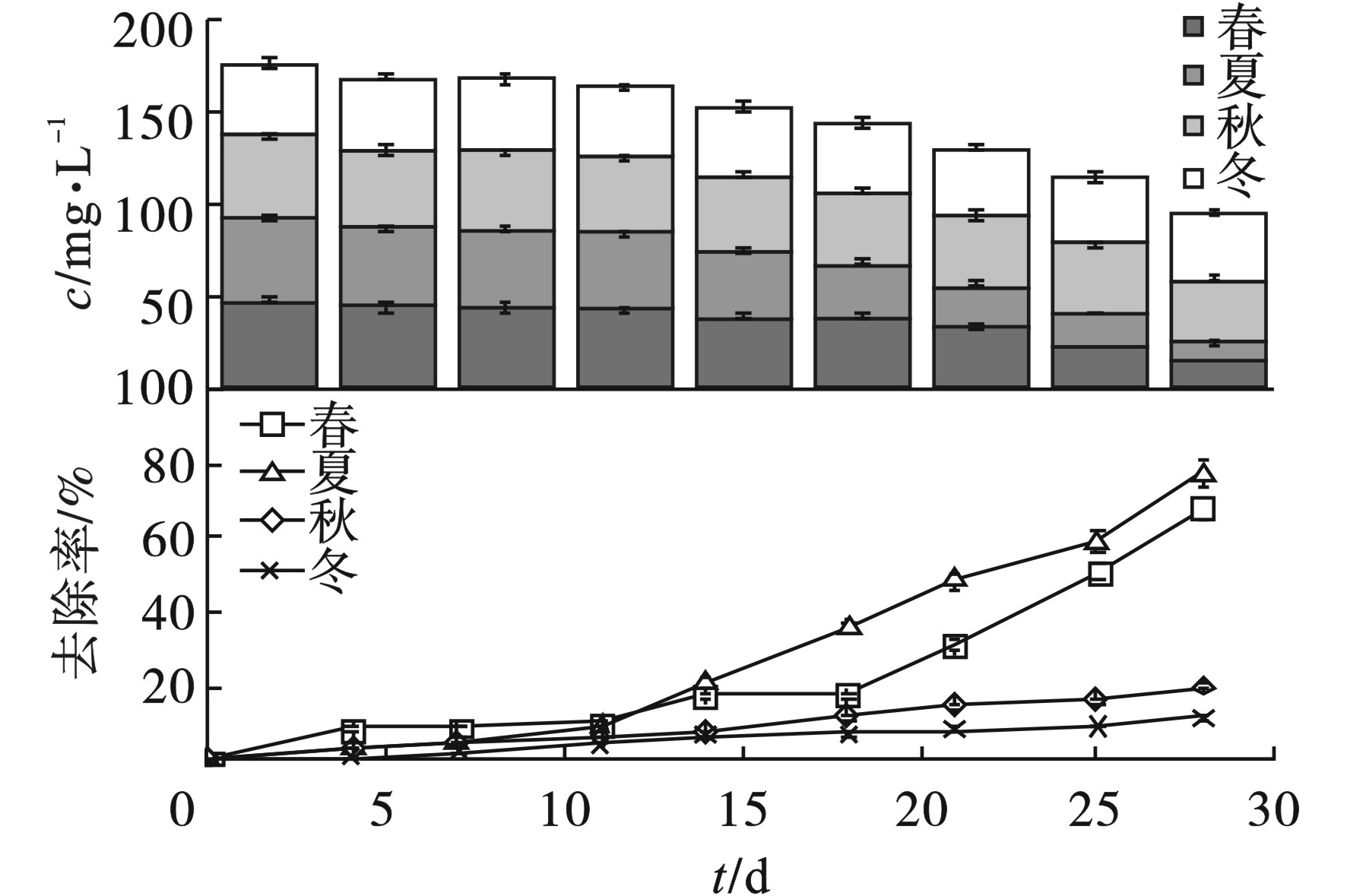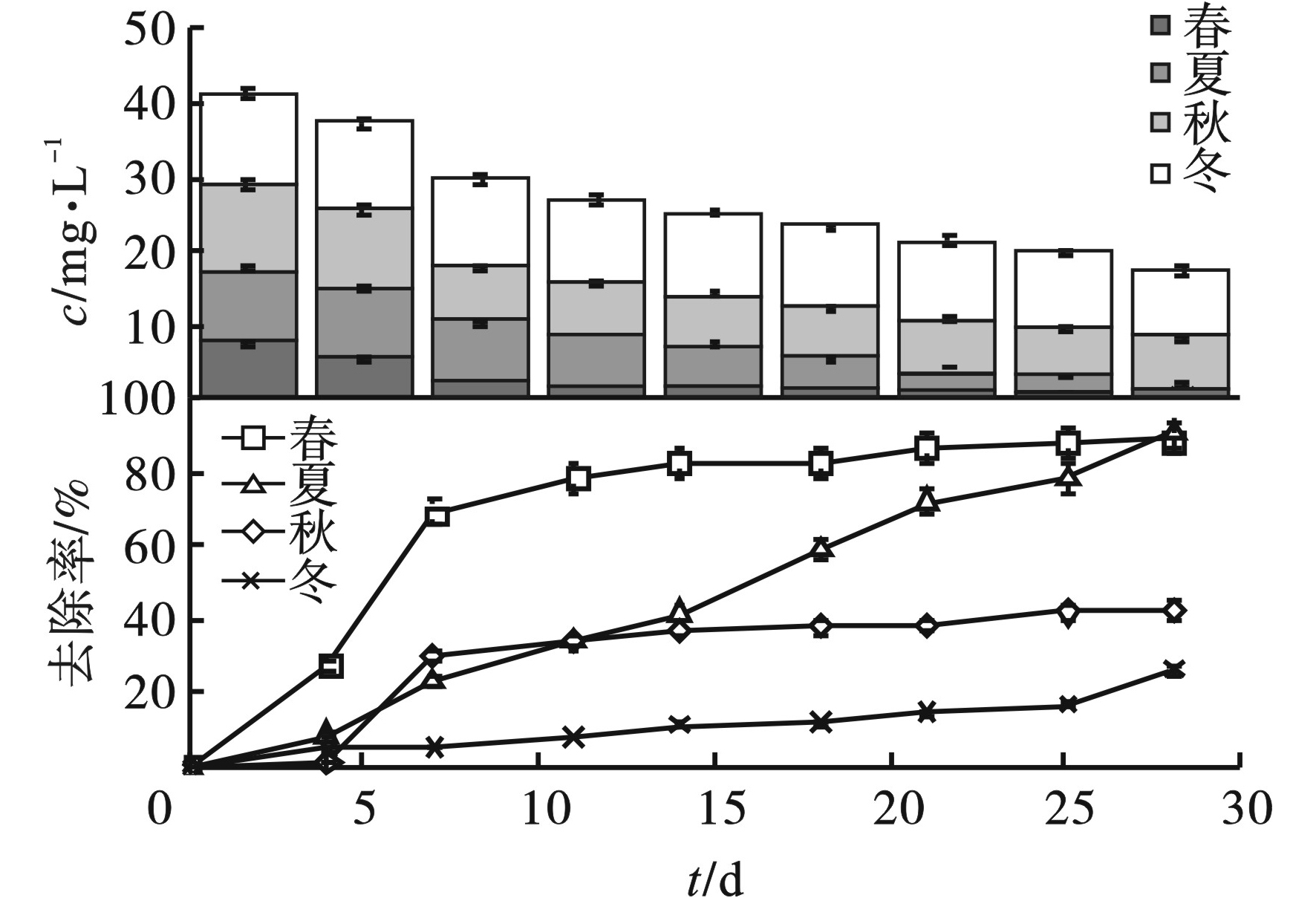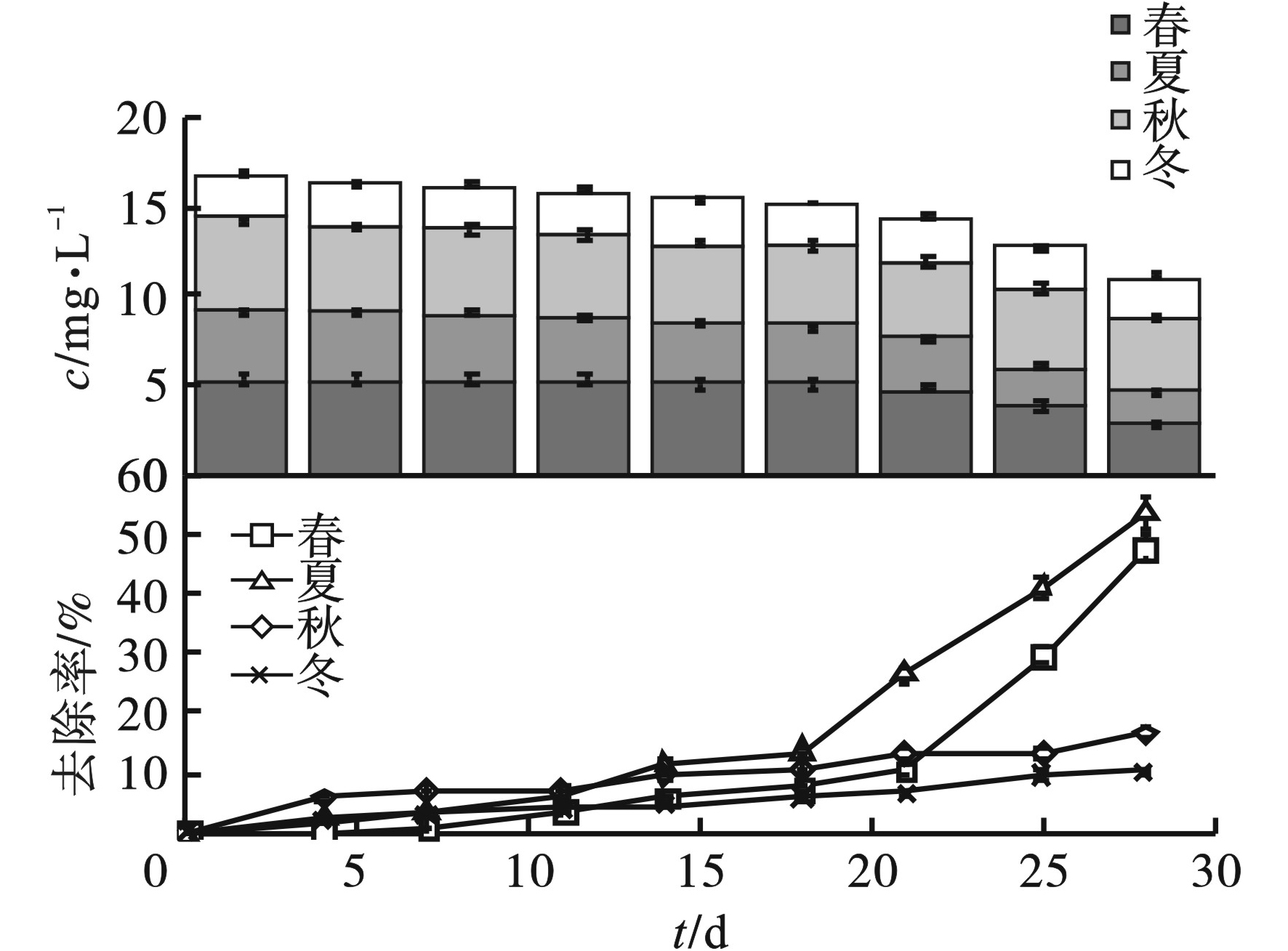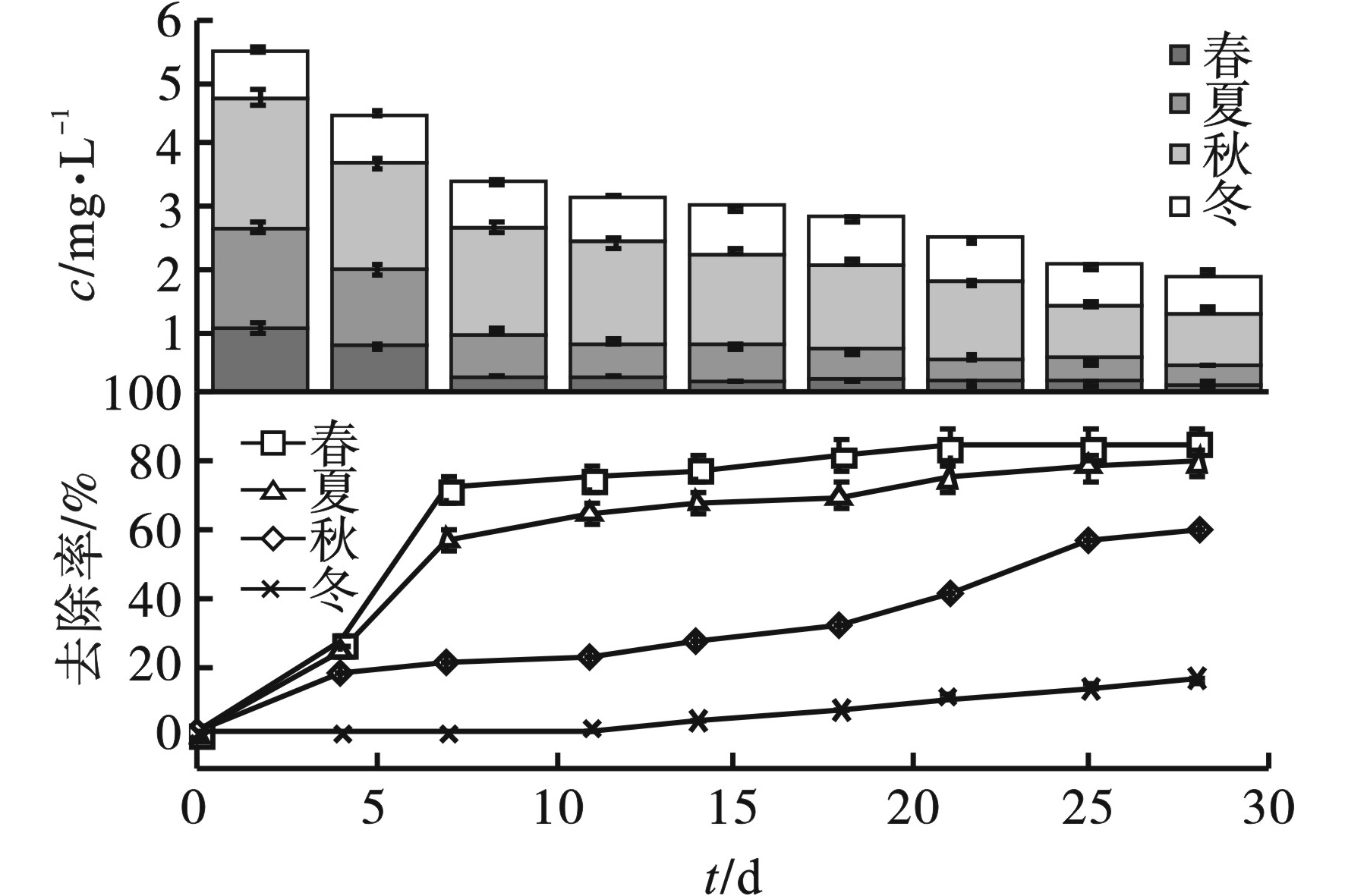-
人工浮床采用无土栽培技术原理,将挺水植物种植于漂浮在水面的浮床上,使植物根系淹没在水中与污染物直接接触,利用根际过滤、植物吸收、植物降解和微生物降解等作用去除水中污染物[1]。浮床植物修复治理污水受多种条件限制,如植物生长、污染程度和微生物协同作用等因素。植物的生长受季节变化影响,特别是季节变化带来的温度和光照时间的影响较大。植物对污染物的去除还受到污水污染程度的制约,污水污染严重可能对植物产生毒害作用导致生长受限,给处理效果带来波动性[2]。
美人蕉(Canna indica)是多年宿根草本植物,根系发达,存活率高,花果期长(北方6~10月,南方3~12月),可陆生、湿生和水生,广泛分布在我国大陆的南北各个地区,是污水和河道植物修复的常用挺水植物[3-4]。人工湿地中美人蕉的相关研究较多[5-7],但对美人蕉在人工浮床中应用效果的研究还不多见,尤其是美人蕉在各个季节移栽后的生长情况和脱氮除磷效果等方面的研究较少。本实验以人工浮床形式在春、夏、秋和冬4个季节分别培育美人蕉,研究同一生长阶段的美人蕉在不同季节对不同浓度污水中氮和磷等营养元素的去除效果,探索美人蕉脱氮除磷能力受季节变化的影响,以期为美人蕉在污水处理中的全年栽种收割提供一定的研究基础。
全文HTML
-
实验采用2种污水浓度,采自合肥区域(31°49′21.30″N,117°13′18.25″E)不同村镇污水厂进水,分别为高浓度污水和低浓度污水进行实验。不同季节高、低浓度污水的初始浓度平均值,见表1。
-
根据气象划分法,春季为阳历3~5月,夏季为6~8月,秋季为9~11月,冬季为12~2月份。在2019年4月~2020年1月期间,选择4月、7月、10月和1月分别代表春季、夏季、秋季和冬季进行美人蕉处理村镇污水实验。每个季节实验周期28 d,控制实验设计保持一致。在各个季节,分别选择若干茎长30~40 cm、根数20~25个、鲜重50 g左右的健康新鲜美人蕉植株清洗干净,在自来水中培养1周后移栽到污水中。实验采用PP水箱,尺寸为长×宽×高=75 cm×25 cm×50 cm,容积为93.74 L,下部一侧开孔装有阀门便于放水,植物由厚5 cm白色泡沫板固定在水箱内,水箱四周用黑色塑料膜包裹避光。每个水箱中装入45 L实验用水,栽种3棵美人蕉,植株覆盖率为16株/m2。同一浓度污水设置3个平行实验,每次实验设置不种植物的空白对照,用白色泡沫板覆盖空白组表面。实验过程中每周期每隔2~3 d取水样,共9次,参照《水和废水检测分析方法》(第四版)中过硫酸钾氧化紫外分光光度法测定TN(总氮)和钼锑抗分光光度法测定TP(总磷)含量[8];每周测量记录植株鲜重、茎长、根数和分蘖数。经去除空白对照的结果后计算污染物去除率和单位面积污染物总去除量。
污染物去除率,见式(1)。
单位面积污染物总去除量计算,见式(2)。
式(1)~(2)中,C0为水中污染物初始浓度,mg/L;Ci为第i d取样污染物浓度,mg/L,i=0~28;R为单位面积污染物总去除量,表示每平方米水面对应的污染物的去除量,g/m2;Ce为水中污染物最终浓度,mg/L;V为单个水箱中污水体积,L;M为单个水箱面积,cm2。
相关性分析采用SPSS软件进行,利用Pearson相关系数分析。
1.1. 实验用水
1.2. 实验方法
-
经测量,实验条件下四季的室温和水温分别如下:4月28.5和23.1 ℃、7月38.5 和31 ℃、10月18.3和20.2 ℃、1月5.4 和9.5 ℃。实验期间美人蕉均能正常生存,每个试验阶段在茎叶、根数和鲜重上有不同程度增长,除冬季外美人蕉均分蘖出新叶,美人蕉在不同情况下经过28 d后的生长情况,见表2。
表2可知,美人蕉的生长情况表现为夏季和春季生长情况优于秋季和冬季,且高浓度污水中的生长速度较低浓度污水迅速,高浓度污水中春夏秋冬鲜重增重分别为:265、305、114 和38 g,低浓度污水分别增重248、255、97和36 g。由此可见,植物的生长不仅受温度影响,也受营养成分含量的高低影响,在适宜温度下,养分成分含量高则植物生长旺盛。另外,实验还发现夏季和春季美人蕉刚移栽的第0~7 d出现部分叶边枯焦现象,主要是阳光直照温度较高导致在适应缓冲阶段美人蕉生长受阻,秋、冬季节则无此情况。
-
分别经过28 d处理后,不同季节污染物的去除效果用单位面积污染物总去除量表示,TN和TP的去除量数据进行方差分析后结果见表3。
表3可知,美人蕉在氮和磷去除方面差异均达到了显著水平(P<0.05)。美人蕉浮床对污水中氮和磷的去除发挥了重要作用,表3中数据越大说明去除能力越强。温度和污水浓度都影响着美人蕉浮床脱氮除磷效果。不同条件下美人蕉对TN和TP的去除效果存在明显差异,同一季节高浓度污水中TN和TP的去除量比低浓度污水高,同一污水浓度夏季去除量较春、秋和冬季高,冬季去除量最低。其中,夏季TN的单位面积总去除量分别为高浓度污水24.86 g/m2,低浓度污水6.59 g/m2,相应TP分别为1.45和0.92 g/m2。经计算,高浓度污水中夏季TN和TP去除量是冬季去除量的7~8倍。由此可见,美人蕉浮床在夏季高浓度污水中脱氮除磷的效果最好,冬季无论在高、低浓度污水中脱氮除磷的效果均最差。
-
高浓度污水和低浓度污水中TN在不同季节经美人蕉处理后的浓度和去除率变化情况,见图1和图2。
图1和图2可见,实验过程中污水中TN浓度持续下降,总体上高浓度TN减少量大于低浓度TN,但减少幅度较小,冬季变化尤不明显。高浓度污水实验,分别经过28 d处理后,春季水箱中污水TN浓度从48.8 mg/L下降至15.6 mg/L,减少了33.2 mg/L;夏季从44.5 mg/L下降至9.99 mg/L,减少了34.51 mg/L;秋季和冬季分别减少了8.90和4.70 mg/L。而低浓度污水TN浓度分别依次减少了6.64、9.15、4.77和3.26 mg/L。
图1中表明高浓度污水TN在夏季的去除率为77.55%,较其他季节高。在种植28 d内,各个季节TN的阶段去除率自第7 d后逐渐增加,使得去除率出现明显上升的拐点。从去除率折线趋势可以看出,随着美人蕉种植时间的延长,高浓度污水中TN的去除率持续高速增加,经计算第25~28 d时阶段去除率分别为夏季17.98%、春季17.00%、秋季3.86%和冬季2.51%。在图2中不同季节低浓度污水中TN的去除率均较高于高浓度污水,美人蕉种植28 d后累积去除率由高到低分别为夏季90.36%、春季88.89%、秋季42.56%和冬季26.50%。低浓度污水TN的去除速率在春季和秋季呈现先大后小的趋势,而夏季和冬季则波动较小,春、秋季节中从第7 d开始TN去除率增加变得平缓。其中,第4~7 d时春夏秋冬的阶段去除率分别为40.96%、23.03%、28.75%和0.81%,第25~28 d时分别为0.94%、11.88%、0.69%和9.43%。说明随着TN浓度逐渐降低至2.34 mg/L之后,植物对氮的去除效率逐渐减弱。
结合图1和图2,不同季节种植美人蕉浮床实验经过28 d从处理,对污水中TN的去除效果由高到低依次为夏季>春季>秋季>冬季。
-
不同季节高浓度污水和低浓度污水中TP去除率情况,见图3和图4。
TP的去除率变化趋势与TN相似。说明种植美人蕉的人工浮床系统对污水脱氮除磷主要依靠植物的吸收去除,对氮、磷的利用存在相关性。美人蕉浮床处理后的污水中TP浓度逐渐减少,28 d后春季高浓度污水中TP浓度从5.41下降为2.83 mg/L,夏季从3.75下降为1.74 mg/L、秋季从4.99降至4.17 mg/L、冬季则从2.61降至2.34 mg/L,秋季和冬季美人蕉浮床去除的TP量明显少于春季和夏季。低浓度污水中TP浓度下降较为明显,但冬季浓度变化较其他3个季节明显减弱,春季从1.04降至0.15 mg/L,夏季从1.61 mg/L降至0.33,秋季从2.10 mg/L降至0.84 mg/L,冬季从0.74降至0.62 mg/L。
图3可见,高浓度污水中不同季节TP的去除率有较大差别,夏季去除率最大,其次是春季,秋季和冬季较低,分别为53.60%、47.69%、16.43%和10.34%。TP去除率在季节的变化趋势不同,春、夏季分别在第18 d和第21 d后突增,秋季和冬季在各个阶段去除效果相差不大。图4可见,低浓度污水中TP的去除率在不同季节变化情况有所差异,春季和夏季在第0~7 d的TP去除较第7~28 d多,而秋季和冬季在各个阶段去除率都相近。第4~7 d春季和夏季TP阶段去除率分别为45.19%和32.51%。低浓度污水TP去除率由高到低依次为春季、夏季、秋季和冬季,分别为85.58%、79.50%、60.00%和16.22%,比高浓度污水相应季节去除率高出31.98%、31.81%、44.00%和5.88%。对污水TP来说,美人蕉浮床对低浓度污水处理效果更好,同时受季节温度变化影响较大,温度下降后去除率明显下降。
-
实验对美人蕉浮床处理村镇污水不同季节TN和TP去除率进行了相关性分析。采用Pearson相关性检测方法,得到4个季节下相关性分析结果,见表4。不同实验条件下,TN去除率与TP去除率间均存在显著相关性。
2.1. 不同季节美人蕉生长情况
2.2. 不同季节污染物的去除效果
2.3. 不同季节TN的去除变化
2.4. 不同季节TP的去除变化
2.5. TN和TP去除率相关性
-
植物主要通过根系从根际周围吸收矿质养分以供植物生长所需,美人蕉浮床漂浮在水面上,根系深入污水中,通过根系的吸收、吸附和根际微生物的降解作用去除水中氮、磷等污染物,一定程度上净化了水体[9]。浮床植物去除氮在多种作用下进行:一是植物根系对铵态氮、硝态氮和氨基酸等的吸收,二是根际微生物的硝化反硝化作用将化合氮转化为氮气从而去除[10]。污水中磷主要是以溶解态和颗粒态被根系吸附,通过根系分泌物和呼吸作用产生的能量被植物吸收[11]。磷是植物体内高能磷酸化合物(ATP)的组成元素,吸收进入细胞后迅速参与代谢被同化,而根系对氮的吸收需要消耗能量,植物根系吸收氮的同时始终伴随着磷的吸收,所以TN和TP的去除存在相关性。
根系对污染物的吸收以及吸附作用是浮床植物技术净化污染水体的重要途径,庞大的植物根系不仅提供了良好的污染物吸附转化界面,还为根际微生物提供良好的栖息场所,植物根系增加,微生物种类和数量也会相应增加,因此可提高对污水的净化效率[12]。然而,植物根系的生长往往受到温度的影响,温度过低或过高都可能抑制根系的生长,通常根系的最适温度低于地上部分生长的最适温度,最适生长温度范围为15~25 ℃,最低温度介于8~16 ℃[13]。一般6~38 ℃的范围内,根系对营养物质的吸收随温度升高而增加。温度过高会引起蛋白质变性,而低温则会使植物的新陈代谢变缓,抑制根系生长,直接影响植物的生长和对氮素及磷素的吸收,从而导致TN和TP去除率下降。实验中,美人蕉在夏季和春季根系发达,秋季和冬季则较为稀疏。此外,温度还影响着植物光合作用、呼吸作用等新陈代谢过程,春季和夏季阳光充足、温暖湿润,是美人蕉生长的最适季节,因此脱氮除磷的效果比较理想[14]。通过文献检索也发现,春夏季节美人蕉脱氮除磷的效果优于秋冬季节。郑剑锋等[15]研究了秋冬季节低温条件下美人蕉浮床对重庆富营养化水体氮磷迁移效果,发现在TN浓度15.4~30.2 mg/L、TP浓度1.09~2.20 mg/L水质下种植美人蕉3个月后,氮的去除率为7.2%,磷的去除率为30.7%;牛小磊等[16]在夏季6~8月考察了美人蕉对西安护城河水体净化能力,结果表明,TN的去除率达77.4%,TP的去除率达89%,远高于空白对照的去除率18%和15%。美国的学者WHITE et al[17]采用美人蕉和灯芯草浮床处理模拟雨污废水,在连续流不收割情况下不同季节的脱氮除磷能力存在明显差异,从4~11月底期间,TN日去除量为22.2~331 mg/m2·d,日均去除量有145 mg/m2·d,TP的日去除量达3.5~26.4 mg/m2·d,日均值为13.4 mg/m2·d,且夏季氮和磷的去除率显著高于秋季。
本实验中美人蕉在夏季生长速率最快,生物量也最大,对TN和TP的去除量和去除率显著高于其他季节,高浓度污水TN和TP去除量明显高于低浓度污水。由此表明,在适宜温度范围内,温度越高越有利于美人蕉的生长,美人蕉适合于处理高浓度氮和磷污染污水,同时美人蕉对于低温低浓度污水也有生存和净化能力。所以,在南方地区频繁收割栽种美人蕉浮床用于处理村镇污水是可行的,尤其在春夏季节生长迅速,可以通过频繁收割栽种加快污染物去除效率。




 下载:
下载:




